Philips 190VW8FB User Manual
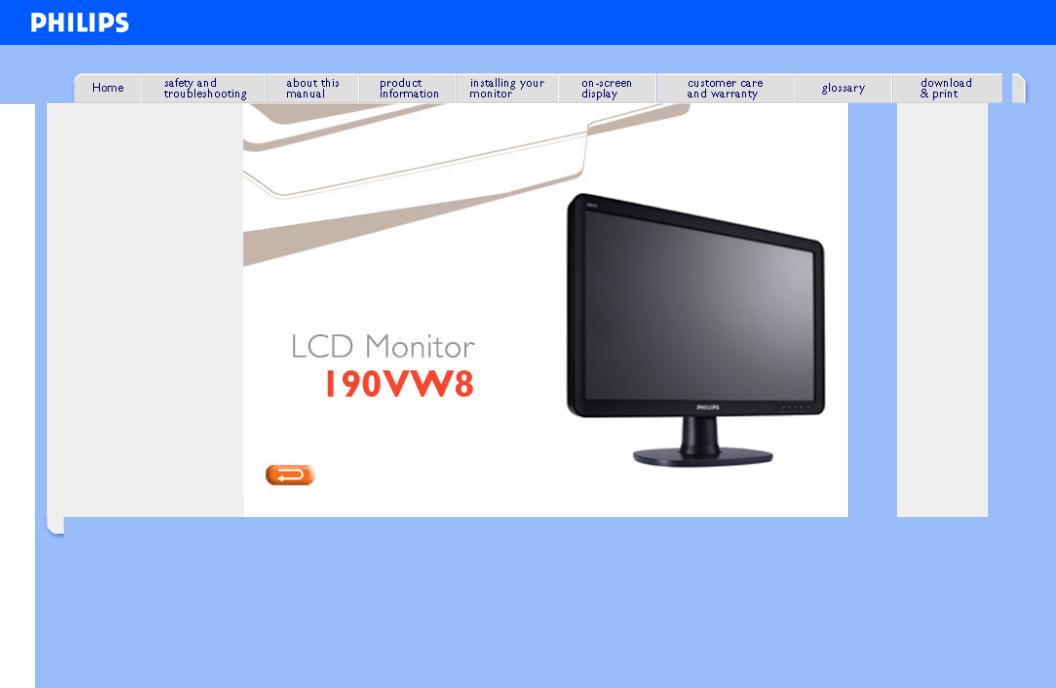
e-Manual
Philips LCD Monitor Electronic User’s Manual
file:////Cnhszhctv1dt476/make%20cd/190VW8/190VW8%20CD/lcd/manual/English/190SW8/INDEX.HTM2007-8-9 15:45:15

Safety and Troubleshooting Information
•Safety Precautions and Maintenance
•FAQs
•Troubleshooting
•Regulatory Information
•Other Related Information
Safety and Troubleshooting Information
Safety precautions and maintenance
WARNING: Use of controls, adjustments or procedures other than those specified in this documentation may result in exposure to shock, electrical hazards and/or mechanical hazards.
Read and follow these instructions when connecting and using your computer monitor:
Operation:
●Keep the monitor out of direct sunlight and away from stoves or any other heat source.
●Remove any object that could fall into ventilation holes or prevent proper cooling of the monitor’s electronics.
●Do not block the ventilation holes on the cabinet.
●When positioning the monitor, make sure the power plug and outlet are easily accessible.
●If turning off the monitor by detaching the power cable or DC power cord, wait for 6 seconds before attaching the power cable or DC power cord for normal operation.
●Please use approved power cord provided by Philips all the time. If your power cord is missing, please contact with your local service center. (Please refer to Customer Care Consumer Information Center)
●Do not subject the LCD monitor to severe vibration or high impact conditions during operation.
●Do not knock or drop the monitor during operation or transportation.
Maintenance:
●To protect your display from possible damage, do not put excessive pressure on the LCD panel. When moving your monitor, grasp the frame to lift; do not lift the monitor by placing your hand or fingers on the LCD panel.
●Unplug the monitor if you are not going to use it for an extensive period of time.
●Unplug the monitor if you need to clean it with a slightly damp cloth. The screen may be wiped with a dry cloth when the power is off. However, never use organic solvent, such as, alcohol, or ammonia-based liquids to clean your monitor.
●To avoid the risk of shock or permanent damage to the set, do not expose the monitor to dust, rain, water, or excessive moisture environment.
●If your monitor gets wet, wipe it with dry cloth as soon as possible.
●If foreign substance or water gets in your monitor, please turn the power off immediately and disconnect the power cord. Then, remove the foreign substance or water, and send it to the maintenance center.
●Do not store or use the LCD monitor in locations exposed to heat, direct sunlight or
file:////Cnhszhctv1dt476/make%20cd/190VW8/190VW8%20CD/lcd/manual/English/190SW8/safety/safety.htm (1 of 2)2007-8-9 15:45:19
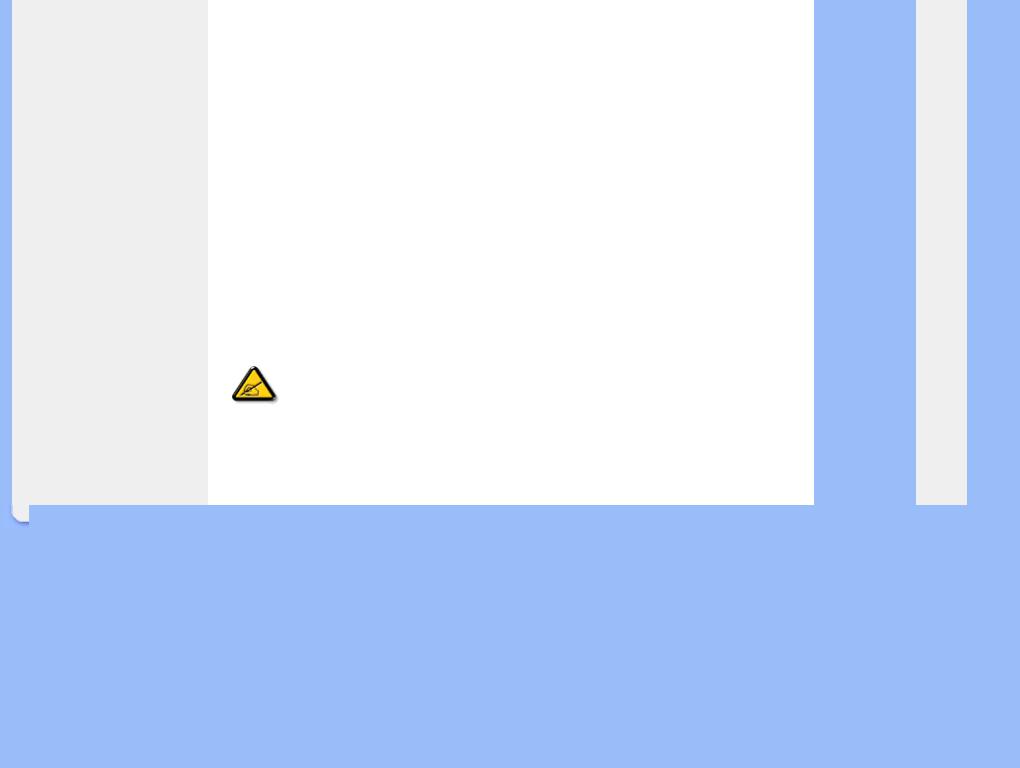
Safety and Troubleshooting Information
extreme cold.
●In order to maintain the best performance of your monitor and use it for a longer lifetime, please use the monitor in a location that falls within the following temperature and humidity ranges.
Temperature: 0-40°C 32-95°F
Humidity: 20-80% RH
●IMPORTANT: Always activate a screen saver program during your application. If a still image in high contrast remains on the screen for an extended period of time, it may leave an 'after-image' or 'ghost image' on front of the screen. This is a well-known phenomenon that is caused by the shortcomings inherent in LCD technology. In most cases, the afterimage will disappear gradually over a period of time after the power has been switched off. Be aware, that the afterimage symptom cannot be repaired and is not covered under warranty.
Service:
●The casing cover should be opened only by qualified service personnel.
●If there is any need for any document for repair or integration, please contact with your local service center. (please refer to the chapter of "Consumer Information Center")
●For transportation information, please refer to "Physical Specifications".
●Do not leave your monitor in a car/trunk under direct sun light.
Consult a service technician if the monitor does not operate normally, or you are not sure what procedure to take when the operating instructions given in this manual have been followed.
RETURN TO TOP OF THE PAGE
file:////Cnhszhctv1dt476/make%20cd/190VW8/190VW8%20CD/lcd/manual/English/190SW8/safety/safety.htm (2 of 2)2007-8-9 15:45:19
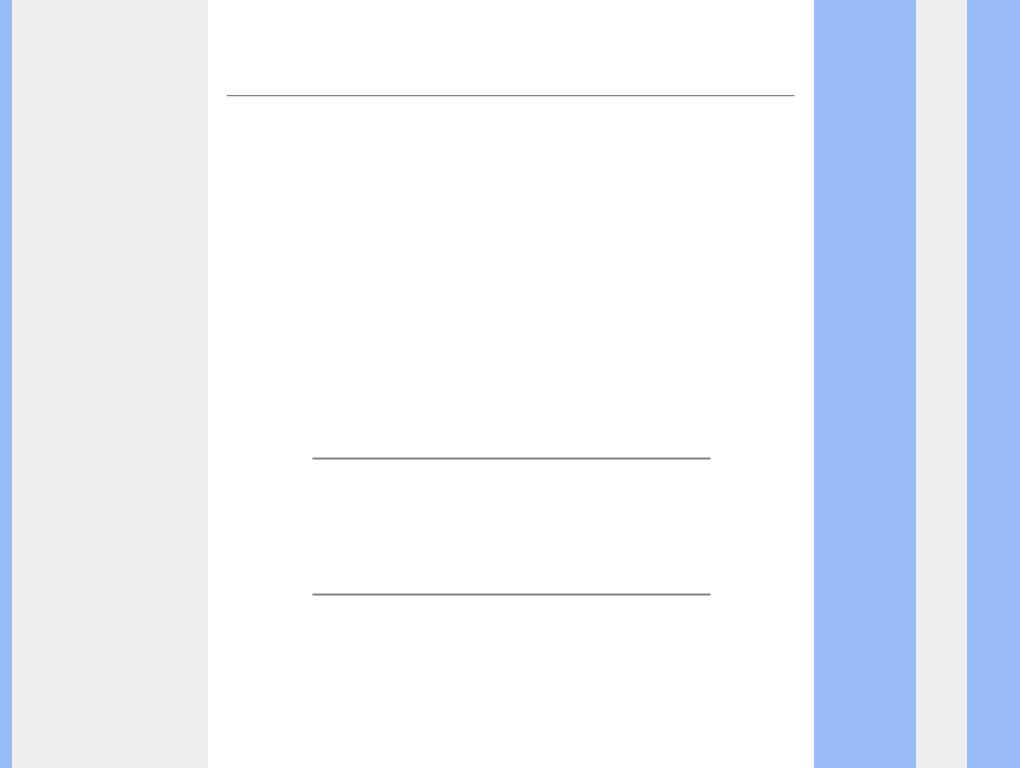
FAQs (Frequently Asked Questions)
•Safety and Troubleshooting
•General FAQs
•Screen Adjustments
•Compatibility with Other Peripherals
•LCD Panel Technology
•Ergonomics, Ecology and Safety Standards
•Troubleshooting
•Regulatory Information
•Other Related Information
FAQs (Frequently Asked Questions)
General FAQs
Q: When I install my monitor what should I do if the screen shows 'Cannot display this video mode'?
A:Recommended video mode for Philips 19": 1440x900 @60Hz.
1.Unplug all cables, then connect your PC to the monitor that you used previously.
2.In the Windows Start Menu, select Settings/Control Panel. In the Control Panel Window, select the Display icon. Inside the Display Control Panel, select the 'Settings' tab. Under the setting tab, in box labeled 'desktop area', move the slidebar to 1440x900 pixels (19").
3.Open 'Advanced Properties' and set the Refresh Rate to 60Hz, then click OK.
4.Restart your computer and repeat step 2 and 3 to verify that your PC is set at 1440x900@60Hz (19").
5.Shut down your computer, disconnect your old monitor and reconnect your Philips LCD monitor.
6.Turn on your monitor and then turn on your PC.
Q:What does 'refresh rate' mean in connection with an LCD monitor?
A:The refresh rate is of much less relevance for LCD monitors. LCD monitors display a stable, flicker-free image at 60Hz. There is no visible difference between 85Hz and 60Hz.
Q: What are the .inf and .icm files on the CD-ROM? How do I install the drivers (.inf and . icm)?
A: These are the driver files for your monitor. Follow the instructions in your user manual to install the drivers. Your computer may ask you for monitor drivers (.inf and . icm files) or a driver disk when you first install your monitor. Follow the instructions to insert the ( companion CD-ROM) included in this package. Monitor drivers (.inf and . icm files) will be installed automatically.
file:////Cnhszhctv1dt476/make%20cd/190VW8/190VW8%20CD/lcd/manual/English/190SW8/safety/saf_faq.htm (1 of 8)2007-8-9 15:45:27
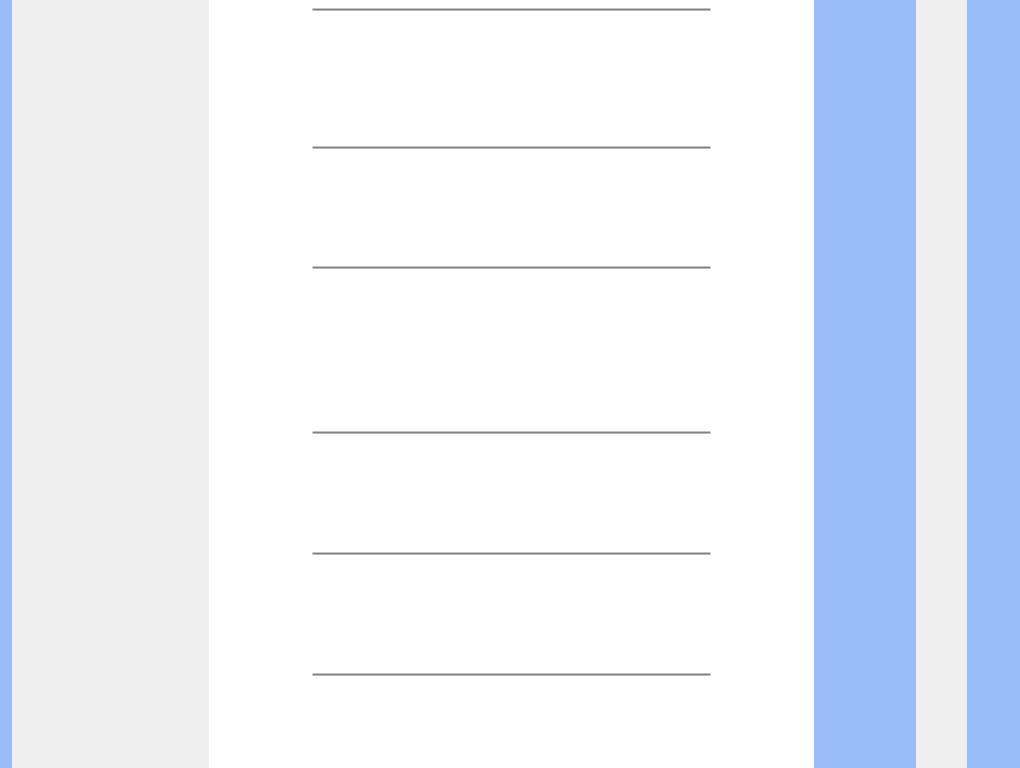
FAQs (Frequently Asked Questions)
Q:How do I adjust the resolution?
A:Your video card/graphic driver and monitor together determine the available resolutions. You can select the desired resolution under Windows® Control Panel with the "Display properties".
Q:What if I get lost when I am making monitor adjustments?
A:Simply press the OK button, then select 'Reset' to recall all of the original factory settings.
Q:What is the Auto function?
A:The AUTO adjustment key restores the optimal screen position, phase and clock settings by pressing of a single button – without the need to navigate through OSD (On Screen Display) menus and control keys.
Note: Auto function is available in selected models only.
Q:My Monitor has no power (Power LED does not light up). What should I do?
A:Make sure the AC power cord is connected between the monitor and AC outlet, and click a key on keyboard/mouse to wake up the PC.
Q:Will the LCD monitor accept an interlaced signal under PC models?
A:No. If an Interlace signal is used, the screen displays both odd and even horizontal scanning lines at the same time, thus distorting the picture.
Q:What does the Refresh Rate mean for LCD?
A:Unlike CRT display technology, in which the speed of the electron beam is swept from the top to the bottom of the screen determines flicker, an active matrix display
file:////Cnhszhctv1dt476/make%20cd/190VW8/190VW8%20CD/lcd/manual/English/190SW8/safety/saf_faq.htm (2 of 8)2007-8-9 15:45:27

FAQs (Frequently Asked Questions)
uses an active element (TFT) to control each individual pixel and the refresh rate is therefore not really applicable to LCD technology.
Q:Will the LCD screen be resistant to scratches?
A:A protective coating is applied to the surface of the LCD, which is durable to a certain extent (approximately up to the hardness of a 2H pencil). In general, it is recommended that the panel surface is not subject to any excessive shocks or
scratches.
Q:How should I clean the LCD surface?
A:For normal cleaning, use a clean, soft cloth. For extensive cleaning, please use isopropyl alcohol. Do not use other solvents such as ethyl alcohol, ethanol, acetone, hexane, etc.
Q:Can I change the color setting of my monitor?
A:Yes, you can change your color setting through OSD control as the following procedures,
1.Press "OK" to show the OSD (On Screen Display) menu
2.Press "Down Arrow" to select the option "Color" then press "OK" to enter color setting, there are three settings as below.
a.Color Temperature; The six settings are 5000K, 6500K, 7500K, 8200K, 9300K and 11500K. With settings in the 5000K range the panel appears ‘warm,' with a red-white color tone, while a 11500K temperature yields ‘cool, blue-white toning."
b.sRGB; this is a standard setting for ensuring correct exchange of colors between different device (e.g. digital cameras, monitors, printers, scanners, etc)
c.User Define; the user can choose his/her preference color setting by adjusting red, green blue color.
*A measurement of the color of light radiated by an object while it is being heated. This measurement is expressed in terms of absolute scale, (degrees Kelvin). Lower Kevin temperatures such as 2004K are red; higher temperatures such as 9300K are
file:////Cnhszhctv1dt476/make%20cd/190VW8/190VW8%20CD/lcd/manual/English/190SW8/safety/saf_faq.htm (3 of 8)2007-8-9 15:45:27

FAQs (Frequently Asked Questions)
blue. Neutral temperature is white, at 6504K.
Q:Can the Philips LCD Monitor be mounted on the wall?
A:Yes. Philips LCD monitors have this optional feature. For standard VESA mount holes on the rear cover allows the user to mount the Philips monitor on most of the VESA standard arms or accessories. We recommend to contact your Philips sales
representative for more information.
RETURN TO TOP OF THE PAGE
Screen Adjustments
Q: When I install my monitor, how do I get the best performance from the monitor?
A:For best performance, make sure your display settings are set at 1440x900@60Hz for 19". Note: You can check the current display settings by pressing the OSD OK button once. The current display mode is shown in OSD first page.
Q:How do LCDs compare to CRTs in terms of radiation?
A:Because LCDs do not use an electron gun, they do not generate the same amount of radiation at the screen surface.
RETURN TO TOP OF THE PAGE
Compatibility with other Peripherals
Q:Can I connect my LCD monitor to any PC, workstation or Mac?
A:Yes. All Philips LCD monitors are fully compatible with standard PCs, Macs and workstations. You may need a cable adapter to connect the monitor to your Mac
file:////Cnhszhctv1dt476/make%20cd/190VW8/190VW8%20CD/lcd/manual/English/190SW8/safety/saf_faq.htm (4 of 8)2007-8-9 15:45:27

FAQs (Frequently Asked Questions)
system. Please contact your Philips sales representative for more information.
Q:Are Philips LCD monitors Plug-and-Play?
A:Yes, the monitors are Plug-and-Play compatible with Windows® 95, 98, 2000, XP and Vista.
Q:What is USB (Universal Serial Bus)?
A:Think of USB as a smart plug for PC peripherals. USB automatically determines resources (like driver software and bus bandwidth) required by peripherals. USB makes necessary resources available without user intervention. There are three main benefits of USB. USB eliminates "case anxiety," the fear of removing the computer case to install circuit board cards -- that often requires adjustment of complicated IRQ settings -- for add-on peripherals. USB does away with "port gridlock." Without USB, PCs are normally limited to one printer, two Com port devices (usually a mouse and modem), one Enhanced Parallel Port add-on (scanner or video camera, for example), and a joystick. More and more peripherals for multimedia computers come on the market every day. With USB, up to 127 devices can run simultaneously on one computer. USB permits "hot plug-in." No need to shut down, plug in, reboot and run set up to install peripherals. No need to go through the reverse process to unplug a device. Bottom line: USB transforms today's "Plug-and-Pray" into true Plug-and-Play!
Please refer to glossary for more information about USB.
Q:What is a USB hub ?
A:A USB hub provides additional connections to the Universal Serial Bus. A hub's upstream port connects a hub to the host, usually a PC. Multiple downstream ports in a hub allows connection to another hub or device, such as a USB keyboard, camera
or printer.
RETURN TO TOP OF THE PAGE
LCD Panel Technology
Q:What is a Liquid Crystal Display?
A:A Liquid Crystal Display (LCD) is an optical device that is commonly used to
file:////Cnhszhctv1dt476/make%20cd/190VW8/190VW8%20CD/lcd/manual/English/190SW8/safety/saf_faq.htm (5 of 8)2007-8-9 15:45:27
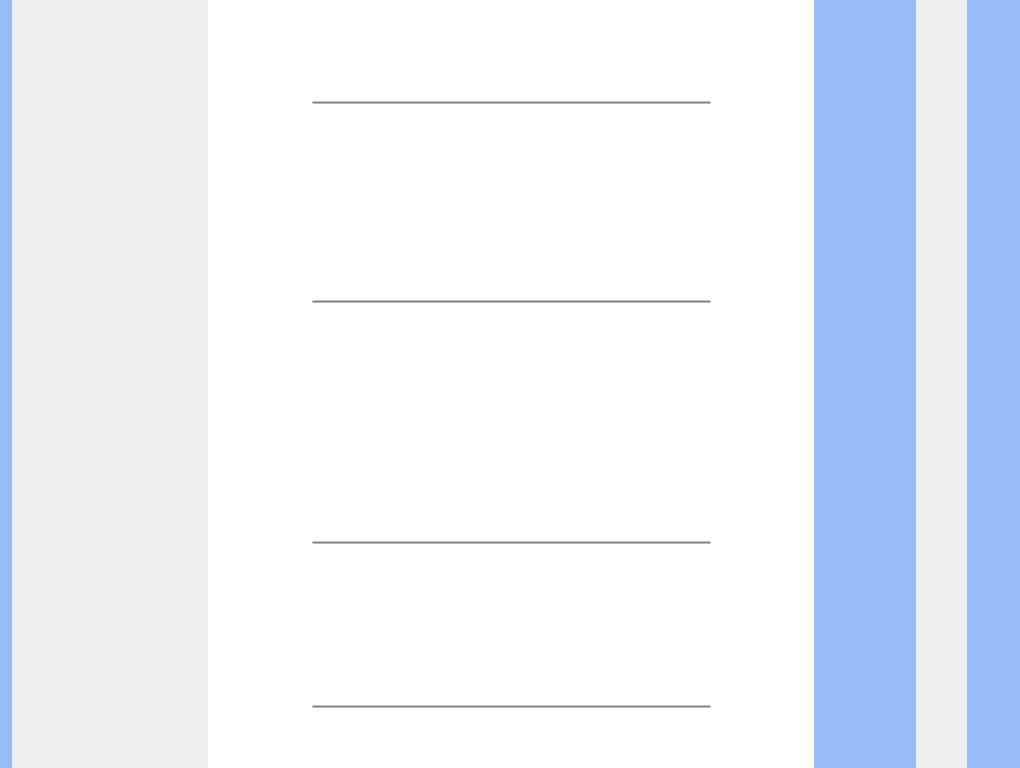
FAQs (Frequently Asked Questions)
display ASCII characters and images on digital items such as watches, calculators, portable game consoles, etc. LCD is the technology used for displays in notebooks and other small computers. Like light-emitting diode and gas-plasma technologies, LCD allows displays to be much thinner than cathode ray tube (CRT) technology.
LCD consumes much less power than LED and gas-displays because it works on the principle of blocking light rather than emitting it.
Q:What differentiates passive matrix LCDs from active matrix LCDs?
A:An LCD is made with either a passive matrix or an active matrix display grid. An active matrix has a transistor located at each pixel intersection, requiring less current to control the luminance of a pixel. For this reason, the current in an active matrix display can be switched on and off more frequently, improving the screen refresh time (your mouse pointer will appear to move more smoothly across the screen, for example). The passive matrix LCD has a grid of conductors with pixels located at
each intersection in the grid.
Q:What are the advantages of TFT LCD compared with CRT?
A:In a CRT monitor, a gun shoots electrons and general light by colliding polarized electrons on fluorescent glass. Therefore, CRT monitors basically operate with an analog RGB signal. A TFT LCD monitor is a device that displays an input image by operating a liquid crystal panel. The TFT has a fundamentally different structure than a CRT: Each cell has an active matrix structure and independent active elements. A TFT LCD has two glass panels and the space between them is filled with liquid crystal. When each cell is connected with electrodes and impressed with voltage, the molecular structure of the liquid crystal is altered and controls the amount of inlet lighting to display images. A TFT LCD has several advantages over a CRT, since it can be very thin and no flickering occurs because it does not use the scanning
method.
Q:Why is vertical frequency of 60Hz optimal for an LCD monitor?
A:Unlike a CDT monitor, the TFT LCD panel has a fixed resolution. For example, an XGA monitor has 1024x3 (R, G, B) x 768 pixels and a higher resolution may not be available without additional software processing. The panel is designed to optimize the display for a 65MHz dot clock, one of the standards for XGA displays. Since the vertical/horizontal frequency for this dot clock is 60Hz/48kHz, the optimum frequency
for this monitor is 60Hz.
Q: What kind of wide-angle technology is available? How does it work?
file:////Cnhszhctv1dt476/make%20cd/190VW8/190VW8%20CD/lcd/manual/English/190SW8/safety/saf_faq.htm (6 of 8)2007-8-9 15:45:27

FAQs (Frequently Asked Questions)
A:The TFT LCD panel is an element that controls/displays the inlet of a backlight using the dual-refraction of a liquid crystal. Using the property that the projection of inlet light refracts toward the major axis of the liquid element, it controls the direction of inlet light and displays it. Since the refraction ratio of inlet light on liquid crystal varies with the inlet angle of the light, the viewing angle of a TFT is much narrower than that of a CDT. Usually, the viewing angle refers to the point where the contrast ration is 10. Many ways to widen the viewing angle are currently being developed and the most common approach is to use a wide viewing angle film, which widens the viewing angle by varying the refraction ratio. IPS (In Plane Switching) or MVA (Multi Vertical Aligned) is also used to give a wider viewing angle.
Q:Why is there no flicker on an LCD Monitor?
A:Technically speaking, LCDs do flicker, but the cause of the phenomenon is different from that of a CRT monitor -- and it has no impact of the ease of viewing. Flickering in an LCD monitor relates to usually undetectable luminance caused by the difference between positive and negative voltage. On the other hand, CRT flickering that can irritate the human eye occurs when the on/off action of the fluorescent object becomes visible. Since the reaction speed of liquid crystal in an LCD panel is much
slower, this troublesome form of flickering is not present in an LCD display.
Q:Why is an LCD monitor virtually low of Electro Magnetic Interference?
A:Unlike a CRT, an LCD monitor does not have key parts that generate Electro Magnetic Interference, especially magnetic fields. Also, since an LCD display utilizes relatively low power, its power supply is extremely quiet.
RETURN TO TOP OF THE PAGE
Ergonomics, Ecology and Safety Standards
Q:What is the CE mark?
A:The CE (Conformité Européenne) mark is required to be displayed on all regulated products offered for sale on the European market. This 'CE' mark means that a product complies with the relevant European Directive. A European Directive is a European 'Law' that relates to health, safety, environment and consumer protection,
much the same as the U.S. National Electrical Code and UL Standards.
file:////Cnhszhctv1dt476/make%20cd/190VW8/190VW8%20CD/lcd/manual/English/190SW8/safety/saf_faq.htm (7 of 8)2007-8-9 15:45:27
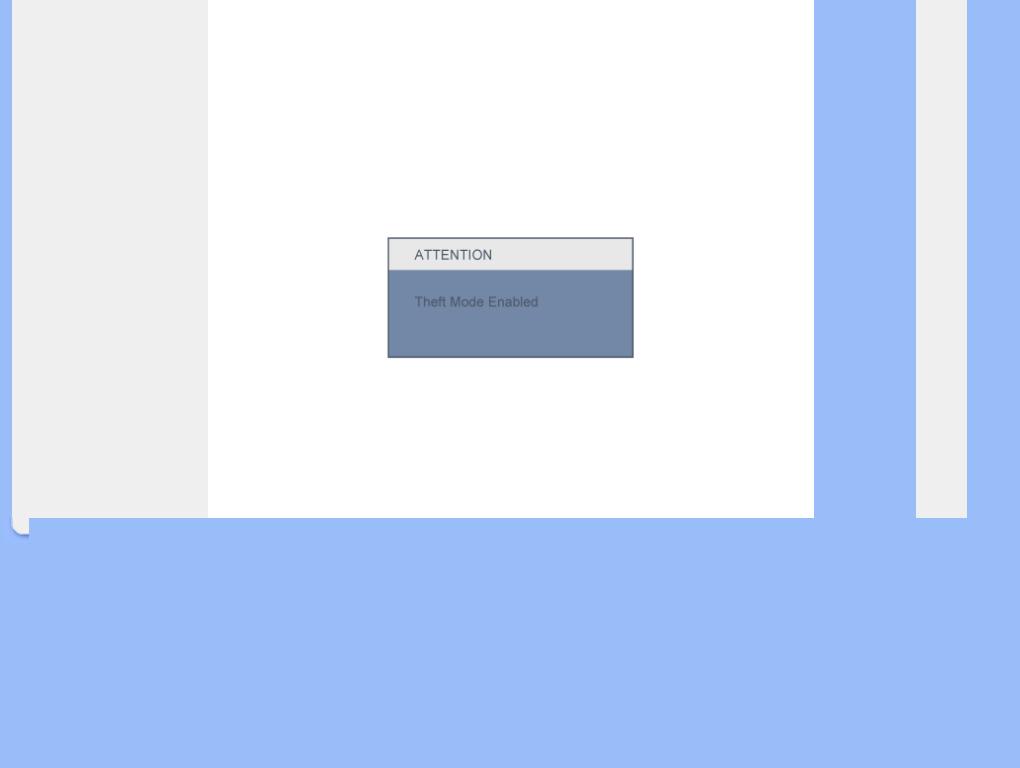
FAQs (Frequently Asked Questions)
Q:Does the LCD monitor conform to general safety standards?
A:Yes. Philips LCD monitors conform to the guidelines of MPR-II and TCO 99/03 standards for the control of radiation, electromagnetic waves, energy reduction, electrical safety in the work environment and recyclability. The specification page provides detailed data on safety standards
More information is provided in the Regulatory Information section.
Q: After I change new PC, I found this information on screen, How can I do?
A: Because you activate Theft Deterrence function in SmartControl II. Please contact
IT manager or Philips Service Center.
RETURN TO TOP OF THE PAGE
file:////Cnhszhctv1dt476/make%20cd/190VW8/190VW8%20CD/lcd/manual/English/190SW8/safety/saf_faq.htm (8 of 8)2007-8-9 15:45:27

Troubleshooting
•Safety and Troubleshooting •FAQs
•Common Problems
•Imaging Problems
•Regulatory Information
•Other Related Information
Troubleshooting
This page deals with problems that can be corrected by a user. If the problem still persists after you have tried these solutions, contact Philips customer service representative.
 Common Problems
Common Problems
 Having this problem
Having this problem
No Picture (Power LED not lit)
No Picture
(Power LED is amber or yellow)
Screen says

 Check these items
Check these items
●Make sure the power cord is plugged into the power outlet and into the back of the monitor.
●First, ensure that the power button on the front of the monitor is in the OFF position, then press it to the ON position.
●Make sure the computer is turned on.
●Make sure the signal cable is properly connected to your computer.
●Check to see if the monitor cable has bent pins.
●The Energy Saving feature may be activated
●Make sure the monitor cable is properly connected to your computer. (Also refer to the Quick Set-Up Guide).
●Check to see if the monitor cable has bent pins.
●Make sure the computer is turned on.
AUTO button not working properly
 Imaging Problems
Imaging Problems
Display position is incorrect
Image vibrates on the screen
●The Auto Function is designed for use on standard Macintosh or IBM-compatible PCs running Microsoft Windows.
●It may not work properly if using nonstandard PC or video card.
●Press the Auto button.
●Adjust the image position using the Phase/Clock of More Settings in OSD Main Controls.
●Check that the signal cable is properly connected to the graphics board or PC.
file:////Cnhszhctv1dt476/make%20cd/190VW8/190VW8%20CD/lcd/manual/English/190SW8/safety/saf_troub.htm (1 of 3)2007-8-9 15:45:28
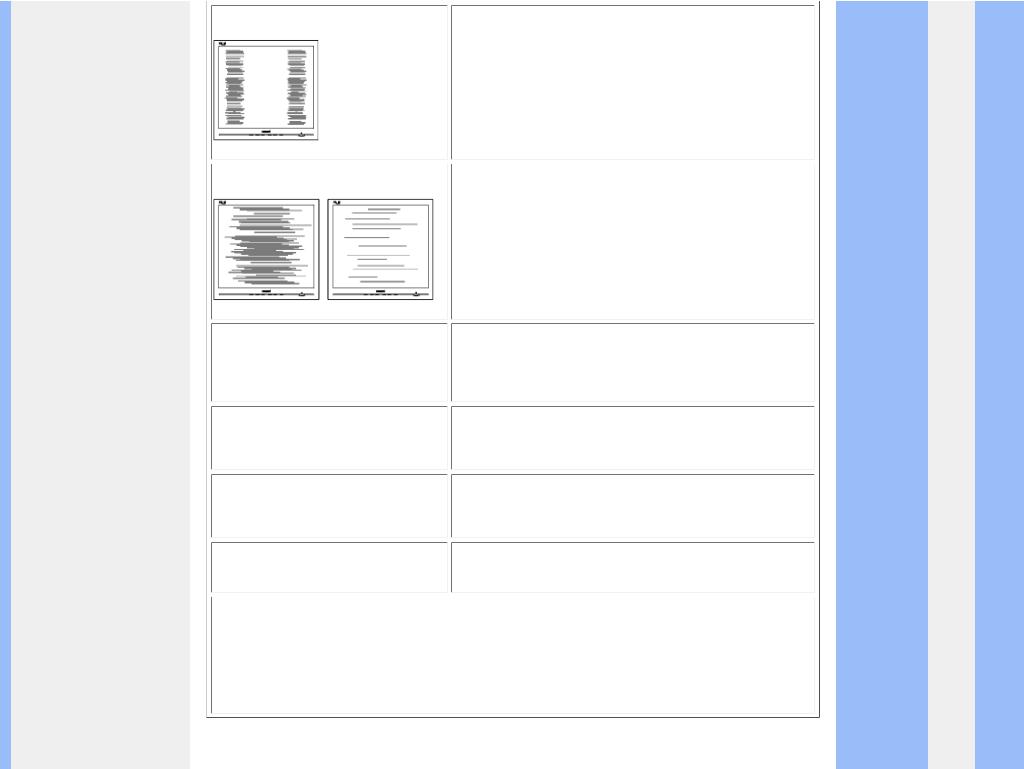
Troubleshooting
Vertical flicker appears
Horizontal flicker appears
The screen is too bright or too dark
An after-image appears
An after-image remains after the power has been turned off.
Green, red, blue, dark, and white dots remains
●Press the Auto button.
●Eliminate the vertical bars using the Phase/Clock of More Settings in OSD Main Controls.
●Press the Auto button.
●Eliminate the vertical bars using the Phase/Clock of More Settings in OSD Main Controls.
●Adjust the contrast and brightness on On-Screen Display. (The backlight of the LCD monitor has a fixed life span. When the screen becomes dark or begins to flicker, please contact your sales representative).
●If an image remains on the screen for an extended period of time, it may be imprinted in the screen and leave an afterimage. This usually disappears after a few hours
●This is characteristic of liquid crystal and is not caused by a malfunction or deterioration of the liquid crystal. The afterimage will disappear after a peroid of time.
●The remaining dots are normal characteristic of the liquid crystal used in today’s technology.
For further assistance, refer to the Consumer Information Centers list and contact Philips customer service representative.
RETURN TO TOP OF THE PAGE
file:////Cnhszhctv1dt476/make%20cd/190VW8/190VW8%20CD/lcd/manual/English/190SW8/safety/saf_troub.htm (2 of 3)2007-8-9 15:45:28

Troubleshooting
file:////Cnhszhctv1dt476/make%20cd/190VW8/190VW8%20CD/lcd/manual/English/190SW8/safety/saf_troub.htm (3 of 3)2007-8-9 15:45:28
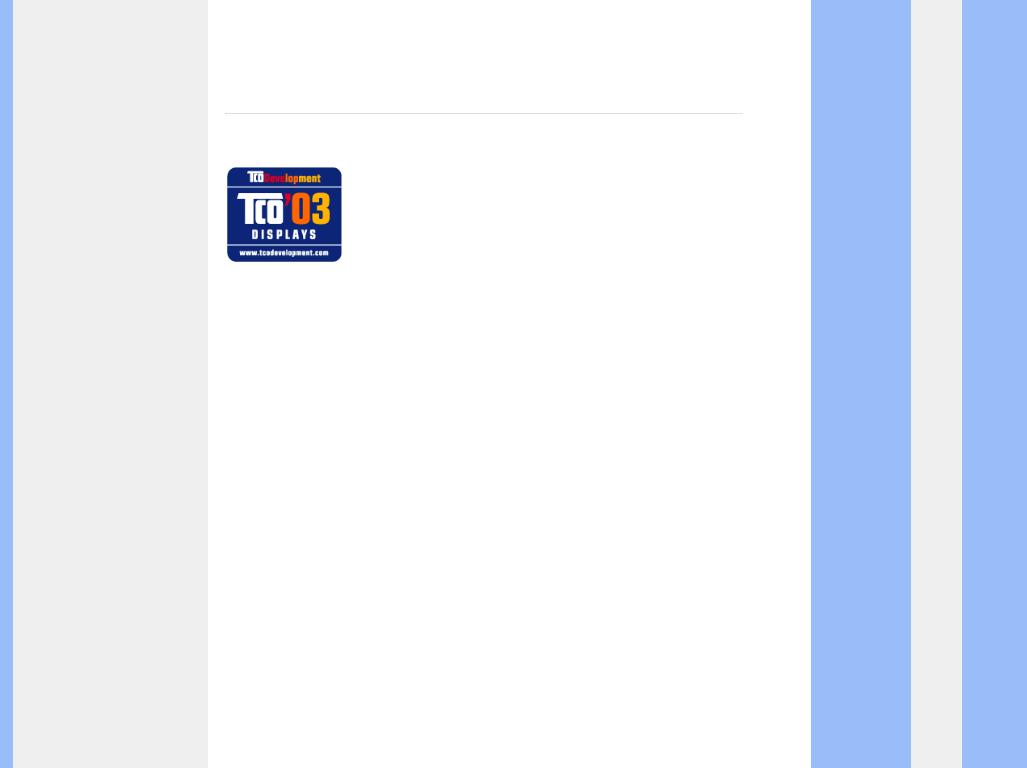
Regulatory Information
•TCO'03 Information
•Recycling Information for Customers
•Waste Electrical and Electronic Equipment-WEEE
•CE Declaration of Conformity
•Energy Star Declaration
•Federal Communications Commission (FCC) Notice (U.S. Only)
•FCC Declaration of Conformity
•Commission Federale de la Communication (FCC Declaration)
•EN 55022 Compliance (Czech Republic Only)
•MIC Notice (South Korea Only)
•Polish Center for Testing and Certification Notice
•North Europe (Nordic Countries) Information
•BSMI Notice (Taiwan Only)
•Ergonomie Hinweis (nur Deutschland)
•Philips End-of-Life Disposal
•Information for UK only
•China RoHS
•Safety Information
•Troubleshooting
•Other Related Information
•Frequently Asked Questions (FAQs)
Regulatory Information
Model ID: |
190VW8 |
Model No: |
HWS8190T |
TCO'03 Information
Congratulations!
The display you have just purchased carries the TCO'03 Displays label. This means that your display is designed, manufactured and tested according to some of the strictest quality and environmental requirements in the world. This makes for a high performance product, designed with the user in focus that also minimizes the impact on our natural environment.
Some of the features of the TCO'03 Display requirements.
Ergonomics
●Good visual ergonomics and image quality in order to improve the working environment for the user and to reduce sight and strain problems. Important parameters are luminance, contrast, resoluction, reflectance, colour rendition and image stability.
Energy
●Energy-saving mode after a certain time-beneficial both for the user and the environment
●Electrical safety
Emissions
●Electromagnetic fields
●Noise emissions
Ecology
●The product must be prepared for recycling and the manufacturer must have a certified environmental management system such as EMAS or ISO 14 000
●Restrictions on
chlorinated and brominated flame retardants and polymers
heavy metals such as cadmium, mercury and lead.
The requirements included in this label have been developed by TCO Development in co-operation with scientists, experts, users as well as manufacturers all over the world. Since the end of the 1980s TCO has been involved in influencing the development of IT equipment in a more user-friendly direction. Our labelling system started with displays in 1992 and is now requested by users and IT-manufacturers all over the world.
For more information, please visit
www.tcodevelopment.com
file:////Cnhszhctv1dt476/make%20cd/190VW8/190VW8%20CD/lcd/manual/English/190SW8/safety/regs/regulat.htm (1 of 11)2007-8-9 15:45:31
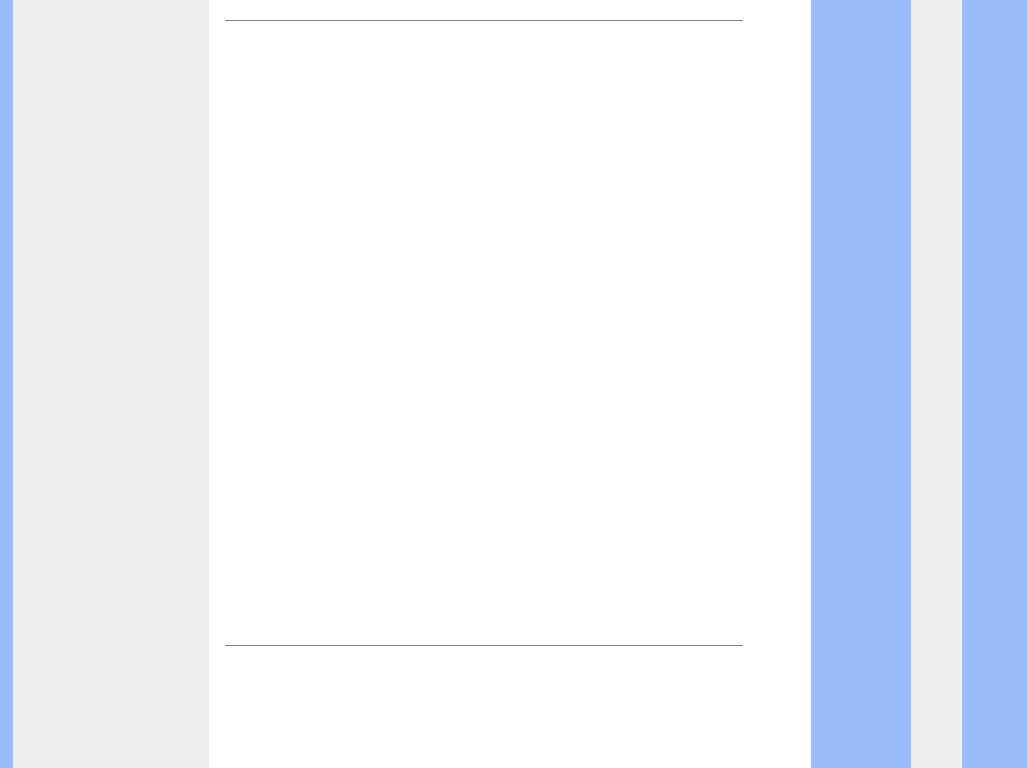
Regulatory Information
RETURN TO TOP OF THE PAGE
Recycling Information for Customers
Philips establishes technically and economically viable objectives to optimize the environmental performance of the organization's product, service and activities.
From the planning, design and production stages, Philips emphasizes the important of making products that can easily be recycled. At Philips, end-of-life management primarily entails participation in national take-back initiatives and recycling programs whenever possible, preferably in cooperation with competitors.
There is currently a system of recycling up and running in the European countries, such as The Netherlands,
Belgium, Norway, Sweden and Denmark.
In U.S.A., Philips Consumer Electronics North America has contributed funds for the Electronic Industries Alliance (EIA) Electronics Recycling Project and state recycling initiatives for end-of-life electronics products from household sources. In addition, the Northeast Recycling Council (NERC) - a multi-state non-profit organization focused on promoting recycling market development - plans to implement a recycling program.
In Asia Pacific, Taiwan, the products can be taken back by Environment Protection Administration (EPA) to follow the IT product recycling management process, detail can be found in web site www.epa.gov.tw
The monitor contains parts that could cause damage to the nature environment. Therefore, it is vital that the monitor is recycled at the end of its life cycle.
For help and service, please contact Consumers Information Center or F1rst Choice Contact Information
Center in each country or the following team of Environmental specialist can help.
Mr. WY ChenEnvironment manager
Philips Multimedia Flat Display
E-mail: w.y.chen@philips.com
Tel: +886 (0) 3 222 6791
Mr. Maarten ten Houten - Senior Environmental Consultant
Philips Consumer Electronics
E-mail: marten.ten.houten@philips.com
Tel: +31 (0) 40 27 33402
Mr. Delmer F. Teglas
Philips Consumer Electronics North America
E-mail: butch.teglas@philips.com
Tel: +1 865 521 4322
RETURN TO TOP OF THE PAGE
Waste Electrical and Electronic Equipment-WEEE
Attention users in European Union private households
file:////Cnhszhctv1dt476/make%20cd/190VW8/190VW8%20CD/lcd/manual/English/190SW8/safety/regs/regulat.htm (2 of 11)2007-8-9 15:45:31

Regulatory Information
 This marking on the product or on its packaging illustrates that, under European Directive 2002/96/EG governing used electrical and electronic appliances, this product may not be disposed of with normal household waste. You are responsible for disposal of this equipment through a designated waste electrical and electronic equipment collection. To determine the locations for dropping off such waste electrical and electronic, contact your local government office, the waste disposal organization that serves your household or the store at which you purchased the product.
This marking on the product or on its packaging illustrates that, under European Directive 2002/96/EG governing used electrical and electronic appliances, this product may not be disposed of with normal household waste. You are responsible for disposal of this equipment through a designated waste electrical and electronic equipment collection. To determine the locations for dropping off such waste electrical and electronic, contact your local government office, the waste disposal organization that serves your household or the store at which you purchased the product.
RETURN TO TOP OF THE PAGE
CE Declaration of Conformity
Philips Consumer Electronics declare under our responsibility that the product is in conformity with the following standards
-EN60950-1:2001 (Safety requirement of Information Technology Equipment)
-EN55022:1998 (Radio Disturbance requirement of Information Technology Equipment)
-EN55024:1998 (Immunity requirement of Information Technology Equipment)
-EN61000-3-2:2000 (Limits for Harmonic Current Emission)
-EN61000-3-3:1995 (Limitation of Voltage Fluctuation and Flicker)
following provisions of directives applicable
-73/23/EEC (Low Voltage Directive)
-89/336/EEC (EMC Directive)
-93/68/EEC (Amendment of EMC and Low Voltage Directive)
and is produced by a manufacturing organization on ISO9000 level.
The product also comply with the following standards
-ISO9241-3, ISO9241-7, ISO9241-8 (Ergonomic requirement for CRT Monitor)
-ISO13406-2 (Ergonomic requirement for Flat Panel Display)
-GS EK1-2000 (GS specification)
-prEN50279:1998 (Low Frequency Electric and Magnetic fields for Visual Display)
-MPR-II (MPR:1990:8/1990:10 Low Frequency Electric and Magnetic fields)
-TCO'99, TCO'03 (Requirement for Environment Labelling of Ergonomics, Energy, Ecology and Emission, TCO: Swedish Confederation of Professional Employees) for TCO versions
RETURN TO TOP OF THE PAGE
Energy Star Declaration
This monitor is equipped with a function for saving energy which supports the VESA Display Power Management Signaling (DPMS) standard. This means that the monitor must be connected to a computer which supports VESA DPMS. Time settings are adjusted from the system unit by software.
|
VESA State |
LED Indicator |
Power Consumption |
Normal operation |
ON (Active) |
Green |
< 36W (typ.) |
file:////Cnhszhctv1dt476/make%20cd/190VW8/190VW8%20CD/lcd/manual/English/190SW8/safety/regs/regulat.htm (3 of 11)2007-8-9 15:45:31
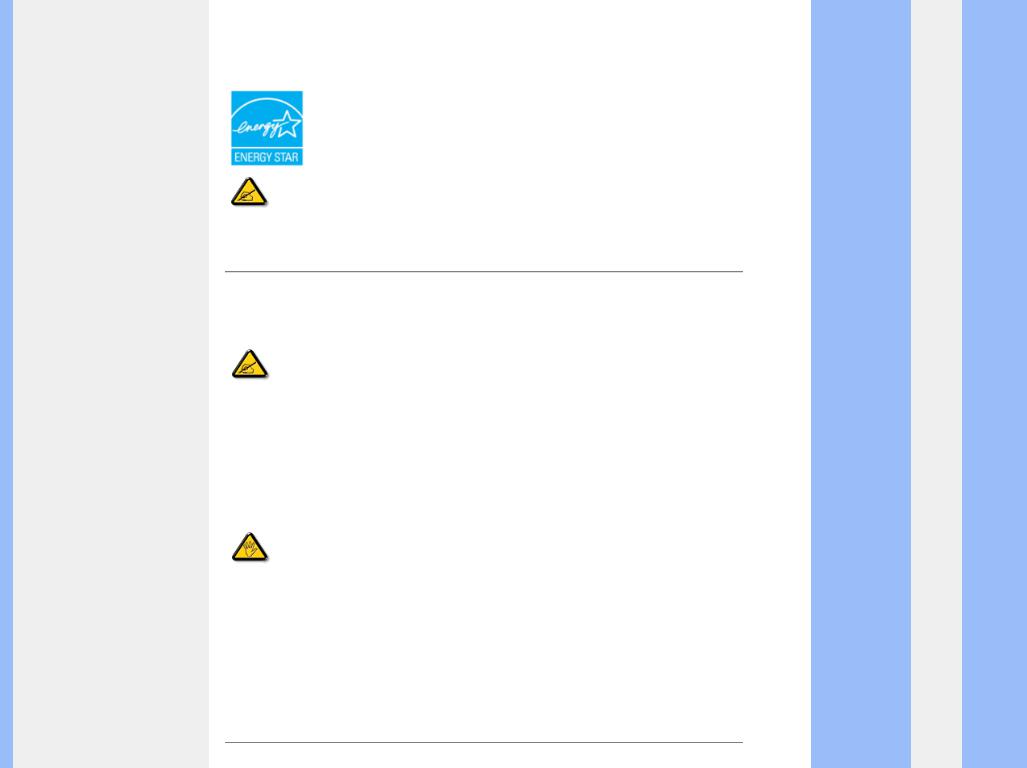
Regulatory Information
Power Saving |
|
|
|
|
Alternative 2 |
OFF (Sleep) |
Amber |
< 1 W |
|
One step |
||||
|
|
|
||
|
Switch Off |
Off |
< 1 W |
|
|
|
|
|
As an ENERGY STAR® Partner, PHILIPS has determined that this product meets the ENERGY STAR® guidelines for energy efficiency.
We recommend you switch off the monitor when it is not in use for a long time.
RETURN TO TOP OF THE PAGE
Federal Communications Commission (FCC) Notice (U.S. Only)
This equipment has been tested and found to comply with the limits for a Class B digital device, pursuant to Part 15 of the FCC Rules. These limits are designed to provide reasonable protection against harmful interference in a residential installation. This equipment generates, uses and can radiate radio frequency energy and, if not installed and used in accordance with the instructions, may cause harmful interference to radio communications. However, there is no guarantee that interference will not occur in a particular installation. If this equipment does cause harmful interference to radio or television reception, which can be determined by turning the equipment off and on, the user is encouraged to try to correct the interference by one or more of the following measures:
●Reorient or relocate the receiving antenna.
●Increase the separation between the equipment and receiver.
●Connect the equipment into an outlet on a circuit different from that to which the receiver is connected.
●Consult the dealer or an experienced radio/TV technician for help.
Changes or modifications not expressly approved by the party responsible for compliance could void the user's authority to operate the equipment.
Use only RF shielded cable that was supplied with the monitor when connecting this monitor to a computer device.
To prevent damage which may result in fire or shock hazard, do not expose this appliance to rain or excessive moisture.
THIS CLASS B DIGITAL APPARATUS MEETS ALL REQUIREMENTS OF THE CANADIAN INTERFERENCE-
CAUSING EQUIPMENT REGULATIONS.
RETURN TO TOP OF THE PAGE
file:////Cnhszhctv1dt476/make%20cd/190VW8/190VW8%20CD/lcd/manual/English/190SW8/safety/regs/regulat.htm (4 of 11)2007-8-9 15:45:31
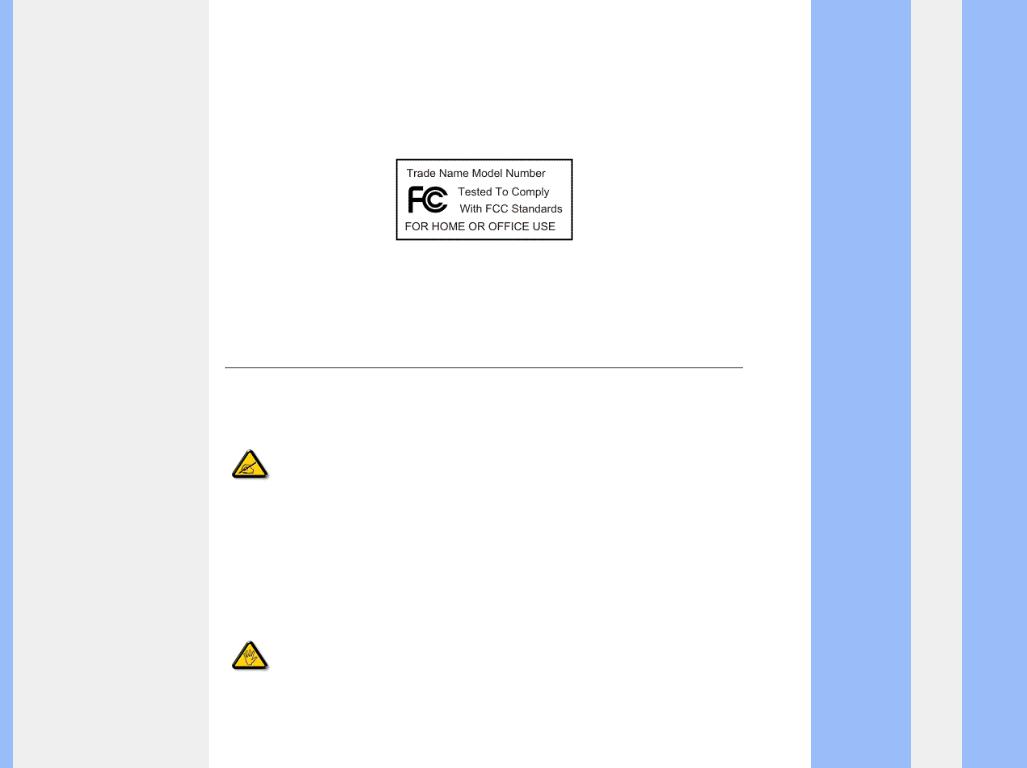
Regulatory Information
FCC Declaration of Conformity
Trade Name: Philips
Philips Consumer Electronics North America
Responsible Party: P.O. Box 671539
Marietta , GA 30006-0026
1-888-PHILIPS (744-5477)
Declaration of Conformity for Products Marked with FCC Logo,
United States Only
This device complies with Part 15 of the FCC Rules. Operation is subject to the following two conditions: (1) this device may not cause harmful interference, and (2) this device must accept any interference received, including interference that may cause undesired operation.
RETURN TO TOP OF THE PAGE
Commission Federale de la Communication (FCC Declaration)
Cet équipement a été testé et déclaré conforme auxlimites des appareils numériques de class B,aux termes de l'article 15 Des règles de la FCC. Ces limites sont conçues de façon à fourir une protection raisonnable contre les interférences nuisibles dans le cadre d'une installation résidentielle. CET appareil produit, utilise et peut émettre des hyperfréquences qui, si l'appareil n'est pas installé et utilisé selon les consignes données, peuvent causer des interférences nuisibles aux communications radio. Cependant, rien ne peut garantir l'absence d'interférences dans le cadre d'une installation particulière. Si cet appareil est la cause d'interférences nuisibles pour la réception des signaux de radio ou de télévision, ce qui peut être décelé en fermant l'équipement, puis en le remettant en fonction, l'utilisateur pourrait essayer de corriger la situation en prenant les mesures suivantes:
●Réorienter ou déplacer l'antenne de réception.
●Augmenter la distance entre l'équipement et le récepteur.
●Brancher l'équipement sur un autre circuit que celui utilisé par le récepteur.
●Demander l'aide du marchand ou d'un technicien chevronné en radio/télévision.
Toutes modifications n'ayant pas reçu l'approbation des services compétents en matière de conformité est susceptible d'interdire à l'utilisateur l'usage du présent équipement.
N'utiliser que des câbles RF armés pour les connections avec des ordinateurs ou périphériques.
CET APPAREIL NUMERIQUE DE LA CLASSE B RESPECTE TOUTES LES EXIGENCES DU REGLEMENT
SUR LE MATERIEL BROUILLEUR DU CANADA.
file:////Cnhszhctv1dt476/make%20cd/190VW8/190VW8%20CD/lcd/manual/English/190SW8/safety/regs/regulat.htm (5 of 11)2007-8-9 15:45:31

Regulatory Information
RETURN TO TOP OF THE PAGE
EN 55022 Compliance (Czech Republic Only)
RETURN TO TOP OF THE PAGE
MIC Notice (South Korea Only)
Class B Device
Please note that this device has been approved for non-business purposes and may be used in any environment, including residential areas.
RETURN TO TOP OF THE PAGE
Polish Center for Testing and Certification Notice
The equipment should draw power from a socket with an attached protection circuit (a three-prong socket). All equipment that works together (computer, monitor, printer, and so on) should have the same power supply source.
The phasing conductor of the room's electrical installation should have a reserve short-circuit protection device in the form of a fuse with a nominal value no larger than 16 amperes (A).
To completely switch off the equipment, the power supply cable must be removed from the power supply socket, which should be located near the equipment and easily accessible.
A protection mark "B" confirms that the equipment is in compliance with the protection usage requirements of standards PN-93/T-42107 and PN-89/E-06251.
file:////Cnhszhctv1dt476/make%20cd/190VW8/190VW8%20CD/lcd/manual/English/190SW8/safety/regs/regulat.htm (6 of 11)2007-8-9 15:45:31
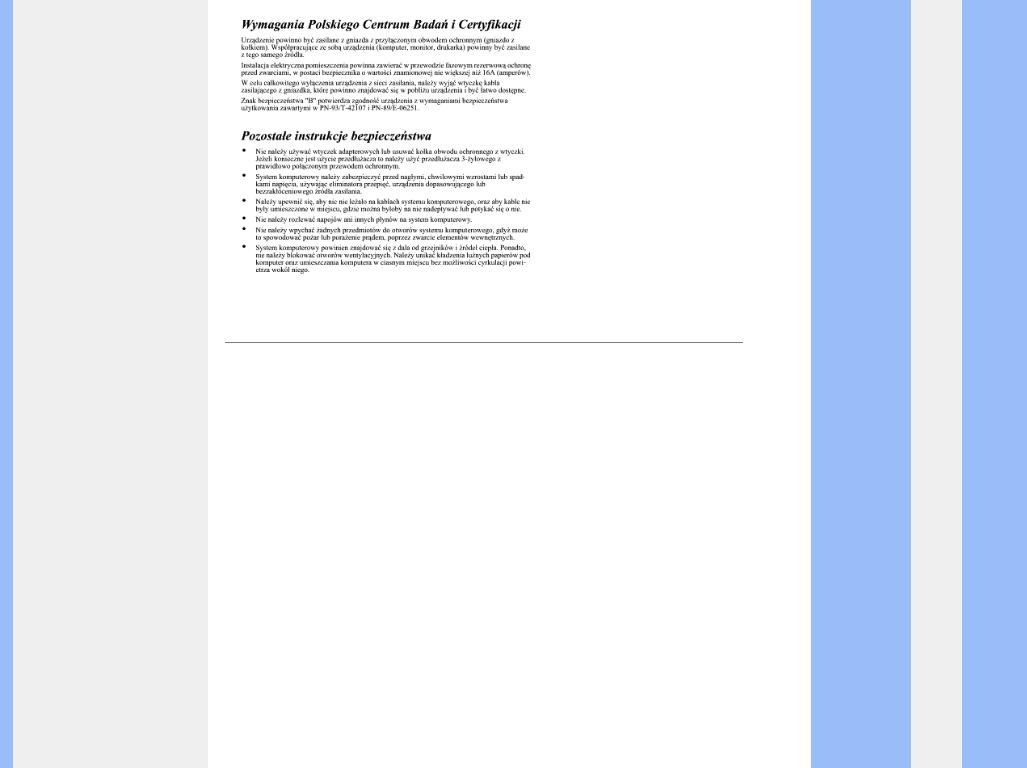
Regulatory Information
RETURN TO TOP OF THE PAGE
North Europe (Nordic Countries) Information
Placering/Ventilation
VARNING:
FÖRSÄKRA DIG OM ATT HUVUDBRYTARE OCH UTTAG ÄR LÄTÅTKOMLIGA, NÄR
DU STÄLLER DIN UTRUSTNING PÅPLATS.
Placering/Ventilation
ADVARSEL:
SØRG VED PLACERINGEN FOR, AT NETLEDNINGENS STIK OG STIKKONTAKT
ER NEMT TILGÆNGELIGE.
Paikka/Ilmankierto
VAROITUS:
SIJOITA LAITE SITEN, ETTÄ VERKKOJOHTO VOIDAAN TARVITTAESSA HELPOSTI
IRROTTAA PISTORASIASTA.
file:////Cnhszhctv1dt476/make%20cd/190VW8/190VW8%20CD/lcd/manual/English/190SW8/safety/regs/regulat.htm (7 of 11)2007-8-9 15:45:31
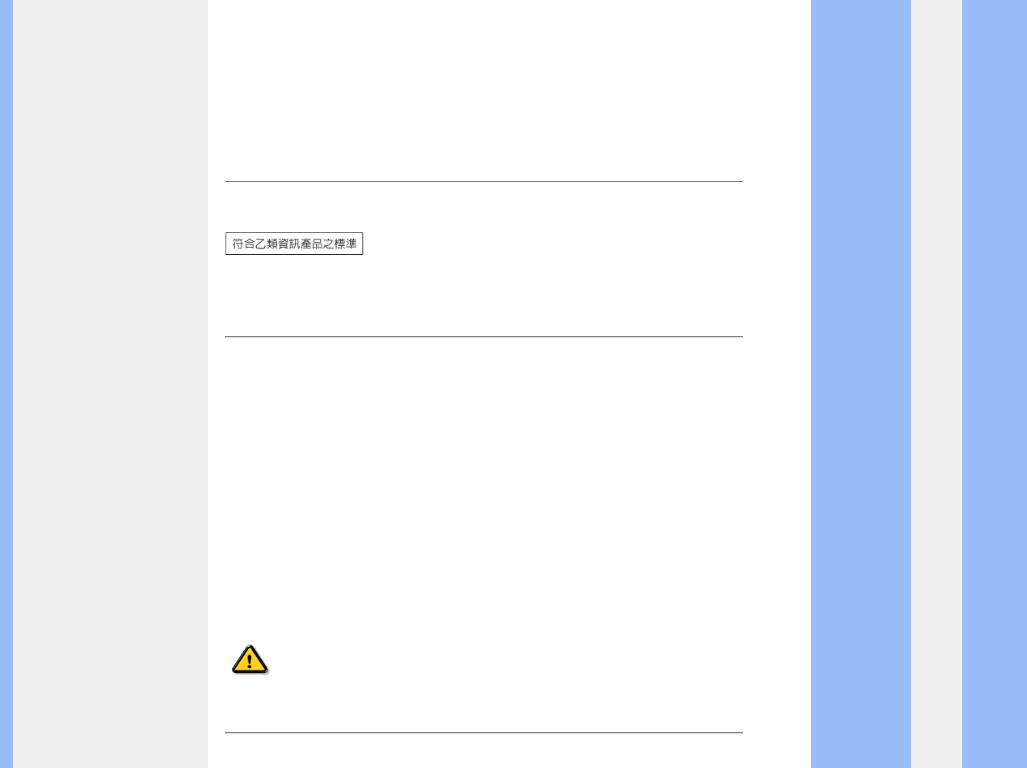
Regulatory Information
Plassering/Ventilasjon
ADVARSEL:
NÅR DETTE UTSTYRET PLASSERES, MÅ DU PASSE PÅ AT KONTAKTENE FOR
STØMTILFØRSEL ER LETTE Å NÅ.
RETURN TO TOP OF THE PAGE
BSMI Notice (Taiwan Only)
RETURN TO TOP OF THE PAGE
Ergonomie Hinweis (nur Deutschland)
Der von uns gelieferte Farbmonitor entspricht den in der "Verordnung über den Schutz vor Schäden durch
Röntgenstrahlen" festgelegten Vorschriften.
Auf der Rückwand des Gerätes befindet sich ein Aufkleber, der auf die Unbedenklichkeit der Inbetriebnahme hinweist, da die Vorschriften über die Bauart von Störstrahlern nach Anlage III ¤ 5 Abs. 4 der Röntgenverordnung erfüllt sind.
Damit Ihr Monitor immer den in der Zulassung geforderten Werten entspricht, ist darauf zu achten, daß
1.Reparaturen nur durch Fachpersonal durchgeführt werden.
2.nur original-Ersatzteile verwendet werden.
3.bei Ersatz der Bildröhre nur eine bauartgleiche eingebaut wird.
Aus ergonomischen Gründen wird empfohlen, die Grundfarben Blau und Rot nicht auf dunklem
Untergrund zu verwenden (schlechte Lesbarkeit und erhöhte Augenbelastung bei zu geringem
Zeichenkontrast wären die Folge).
Der arbeitsplatzbezogene Schalldruckpegel nach DIN 45 635 beträgt 70dB (A) oder weniger.
ACHTUNG: BEIM AUFSTELLEN DIESES GERÄTES DARAUF ACHTEN, DAß
NETZSTECKER UND NETZKABELANSCHLUß LEICHT ZUGÄNGLICH SIND.
RETURN TO TOP OF THE PAGE
End-of-Life Disposal
file:////Cnhszhctv1dt476/make%20cd/190VW8/190VW8%20CD/lcd/manual/English/190SW8/safety/regs/regulat.htm (8 of 11)2007-8-9 15:45:31
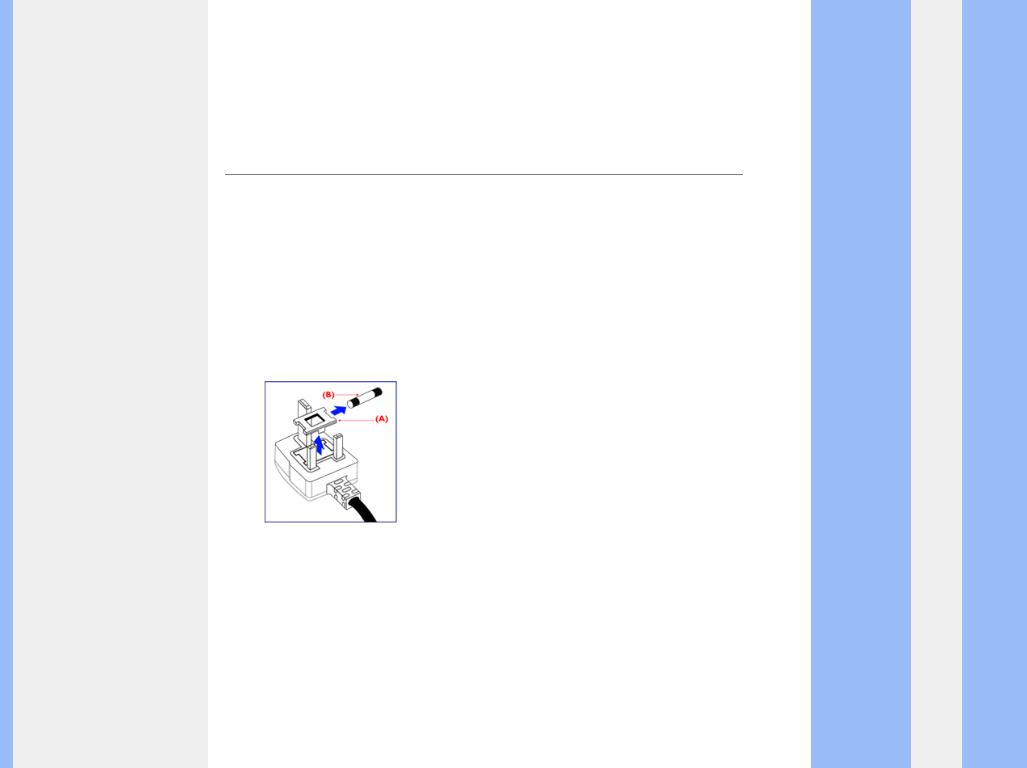
Regulatory Information
Your new monitor contains materials that can be recycled and reused. Specialized companies can recycle your product to increase the amount of reusable materials and to minimize the amount to be disposed of.
Please find out about the local regulations on how to dispose of your old monitor from your local Philips dealer.
(For customers in Canada and U.S.A.)
This product may contain lead and/or mercury. Dispose of in accordance to local-state and federal regulations. For additional information on recycling contact www.eia.org (Consumer Education Initiative)
RETURN TO TOP OF THE PAGE
Information for UK only
WARNING - THIS APPLIANCE MUST BE GROUNDING.
Important:
This apparatus is supplied with an approved moulded 13A plug. To change a fuse in this type of plug proceed as follows:
1. Remove fuse cover and fuse.
2. Fit new fuse which should be a BS 1362 5A,A.S.T.A. or BSI approved type.
3. Refit the fuse cover.
If the fitted plug is not suitable for your socket outlets, it should be cut off and an appropriate 3-pin plug fitted in its place.
If the mains plug contains a fuse, this should have a value of 5A. If a plug without a fuse is used, the fuse at the distribution board should not be greater than 5A.
Note: The severed plug must be destroyed to avoid a possible shock hazard should it be inserted into a 13A socket elsewhere.
How to connect a plug
The wires in the mains lead are coloured in accordance with the following code:
BLUE - "NEUTRAL" ("N")
BROWN - "LIVE" ("L")
GREEN & YELLOW - "GROUND" ("G")
file:////Cnhszhctv1dt476/make%20cd/190VW8/190VW8%20CD/lcd/manual/English/190SW8/safety/regs/regulat.htm (9 of 11)2007-8-9 15:45:31
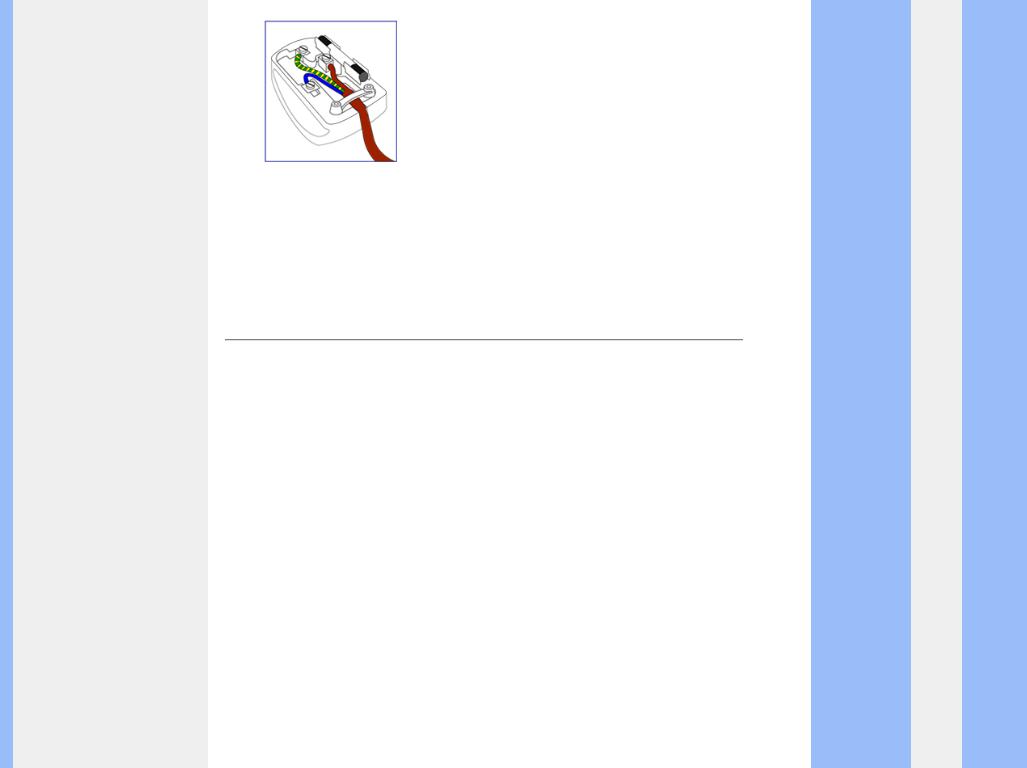
Regulatory Information
1. The GREEN AND YELLOW wire must be connected to the terminal in the plug which is marked with the letter "G"
or by the Ground symbol  or coloured GREEN or GREEN AND YELLOW.
or coloured GREEN or GREEN AND YELLOW.
2. The BLUE wire must be connected to the terminal which is marked with the letter "N" or coloured BLACK.
3. The BROWN wire must be connected to the terminal which marked with the letter "L" or coloured RED.
Before replacing the plug cover, make certain that the cord grip is clamped over the sheath of the lead - not simply over the three wires.
RETURN TO TOP OF THE PAGE
China RoHS
The People's Republic of China released a regulation called "Management Methods for Controlling Pollution by Electronic Information Products" or commonly referred to as China RoHS. All products including CRT and LCD monitor which are produced and sold for China market have to meet China RoHS request.
file:////Cnhszhctv1dt476/make%20cd/190VW8/190VW8%20CD/lcd/manual/English/190SW8/safety/regs/regulat.htm (10 of 11)2007-8-9 15:45:31
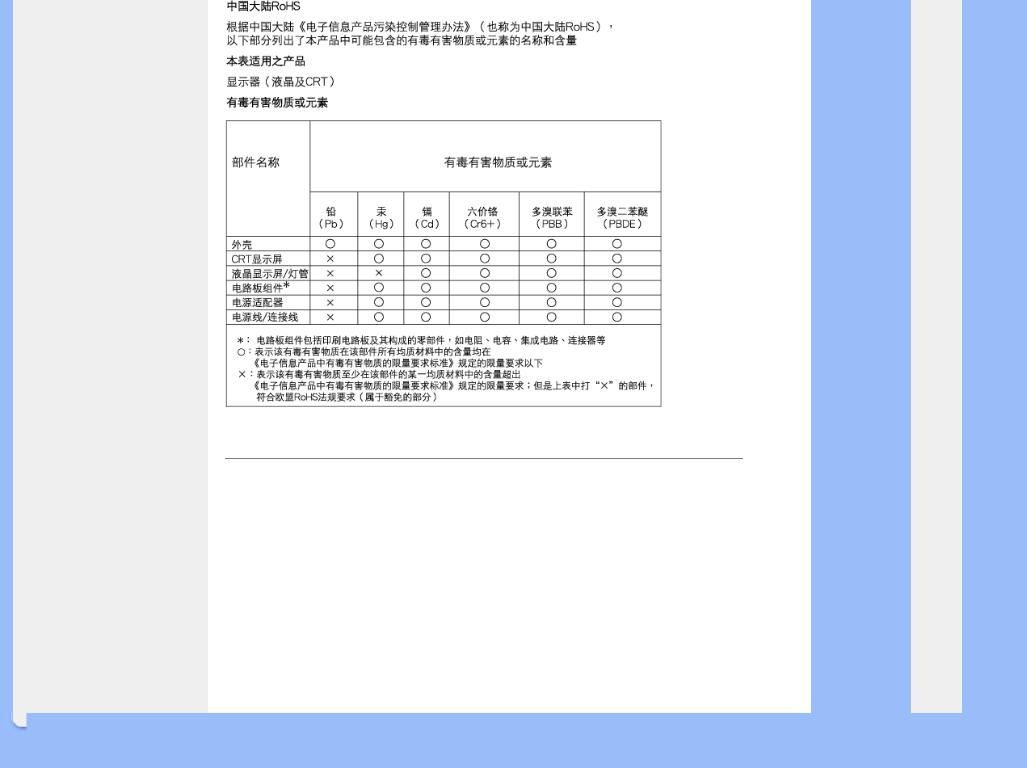
Regulatory Information
RETURN TO TOP OF THE PAGE
Safety Information: Electric, Magnetic and Electromagnetic Fields (“EMF”)
1.Philips Royal Electronics manufactures and sells many products targeted at consumers, which, like any electronic apparatus, in general have the ability to emit and receive electro magnetic signals.
2.One of Philips' leading Business Principles is to take all necessary health and safety measures for our products, to comply with all applicable legal requirements and to stay well within the EMF standards applicable at the time of producing the products.
3.Philips is committed to develop, produce and market products that cause no adverse health effects.
4.Philips confirms that if its products are handled properly for their intended use, they are safe to use according to scientific evidence available today.
5.Philips plays an active role in the development of international EMF and safety standards, enabling Philips to anticipate further developments in standardization for early integration in its products.
RETURN TO TOP OF THE PAGE
file:////Cnhszhctv1dt476/make%20cd/190VW8/190VW8%20CD/lcd/manual/English/190SW8/safety/regs/regulat.htm (11 of 11)2007-8-9 15:45:31

Other Related Information
•Safety and Troubleshooting
•FAQs
•Troubleshooting
•Regulatory Information
•Information
for Users in the U.S
•Information
for Users Outside the U.S
Other Related Information
Information for Users in the U. S.
For units set at 115 V :
Use a UL Listed Cord Set consisting of a minimum 18 AWG, Type SVT or SJT three conductor cord a maximum of 15-feet long and a parallel blade, grounding type attachment plug rated 15 A, 125 V.
For units set at 230 V:
Use a UL Listed Cord Set consisting of a minimum 18 AWG, Type SVT or SJT three conductor cord a maximum of 15-feet long and a tandem blade, grounding type attachment plug rated 15 A, 250 V.
Information for Users outside the U.S.
For units set at 230 V:
Use a Cord Set consisting of a minimum 18 AWG cord and grounding type attachment plug rated 15 A, 250 V. The Cord Set should have the appropriate safety approvals for the country in which the equipment will be installed and / or be marked HAR.
RETURN TO TOP OF THE PAGE
file:////Cnhszhctv1dt476/make%20cd/190VW8/190VW8%20CD/lcd/manual/English/190SW8/safety/saf_other.htm2007-8-9 15:45:31

About This Manual
•About This Guide
•Notational Descriptions
About This Manual
About This Guide
This electronic user's guide is intended for anyone who uses the Philips LCD Monitor. It describes the LCD monitor's features, setup, operation and other important information. Its contents are identical to the information in our printed version.
It includes the following sections:
●Safety and Troubleshooting Information provides tips and solutions for common problems as well as other related information you may need.
●About This Electronic User's Manual gives an overview of information included, along with notation icon descriptions and other documentation for your reference.
●Product Information gives an overview of the monitor's features as well as the technical specifications for this monitor.
●Installing Your Monitor describes the initial setup process and gives an overview of how to use the monitor.
●On-Screen Display provides information on adjusting the settings on your monitor.
●Customer Care and Warranty contains a list of worldwide Philips Consumer Information Centers along with help desk phone numbers and information on the warranty applicable to your product.
●Glossary defines technical terms.
●Download and Print Option transfers this entire manual to your hard drive for easy reference.
RETURN TO TOP OF THE PAGE
Notational Descriptions
The following subsections describe notational conventions used in this document.
Notes, Cautions and Warnings
file:////Cnhszhctv1dt476/make%20cd/190VW8/190VW8%20CD/lcd/manual/English/190SW8/about/about.htm (1 of 2)2007-8-9 15:45:44
